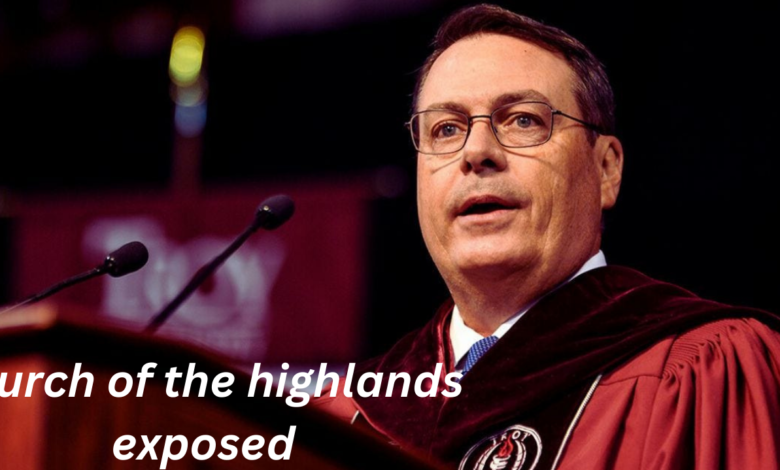Church of the Highlands Exposed A Deep Dive into Its Financial Practices

Church of the Highlands Exposed has taken the Christian community by storm, becoming one of the fastest-growing megachurches in America. With its vibrant services and engaging outreach programs, it has attracted thousands. But behind this façade of success lies a world shrouded in scrutiny and controversy.
As congregants fill their pews each Sunday, questions swirl around the church’s financial practices. Are members’ donations being used responsibly? What does transparency look like for such a large organization? This exploration delves into allegations that have surfaced about Church of the Highlands Exposed financial management and spending habits.
Join us as we peel back the layers on these pressing issues, revealing insights that every member—and potential donor—should know. It’s time to uncover what’s really going on at Church of the Highlands: A deep dive into its financial practices awaits you.
Allegations against Church of the Highlands’ financial practices
Allegations surrounding the Church of the Highlands have raised eyebrows in recent years. Critics claim that financial practices may not align with their professed values.
Some former members have spoken out, suggesting a lack of transparency regarding how donations are utilized. Questions arise about whether funds primarily support church leadership rather than community outreach.
Additionally, there are concerns about lavish spending on facilities and amenities. This has led many to wonder if such expenditures truly reflect the mission of service and stewardship.
The scrutiny doesn’t stop there; accusations also extend to aggressive tithing practices. Many feel pressured to give beyond their means, fueling debate over ethical fundraising tactics within the organization.
As these allegations continue to circulate, they paint a complex picture of financial accountability at Church of the Highlands. The discourse remains heated among both supporters and critics alike.
Exploration of the church’s tax-exempt status and financial records
The tax-exempt status of the Church of the Highlands has long been a topic of discussion. This designation allows religious organizations to operate without paying federal income taxes. While intended to support spiritual missions, it raises questions about financial accountability.
Accessing financial records can be challenging for outsiders. Many churches are not required to disclose detailed information, which complicates public scrutiny.
Some argue that transparency is essential for fostering trust within the community. Without clear insights into how funds are allocated, concerns about mismanagement or misuse arise.
Additionally, critics point out that large congregations like this one often experience significant growth in wealth but lack corresponding visibility in their spending practices. The implications extend beyond mere finances; they touch on ethical considerations regarding stewardship and responsibility to members and donors alike.
Analysis of the church’s spending on salaries, buildings, and outreach programs
A closer look at the Church of the Highlands’ financial allocations reveals significant spending patterns. Salaries for church leaders and staff make up a large portion of the budget. Many wonder if compensation aligns with industry standards, especially given the church’s substantial growth.
Investments in buildings are another focal point. The church has expanded its footprint dramatically over recent years, sparking discussions about whether these expenses serve the community effectively or merely expand brand presence.
Outreach programs often capture hearts and minds, boasting impressive figures on paper. However, scrutiny is essential to determine how much truly benefits those in need versus administrative costs that may inflate numbers without tangible impact.
As members digest this data, questions linger about transparency and accountability within such a rapidly growing institution. The balance between fiscal responsibility and mission-driven outreach remains crucial for long-term trust among congregants.
Controversies surrounding donations and tithing at Church of the Highlands
At Church of the Highlands, donations and tithing have sparked significant debate among congregants. Many members express concern over how their contributions are utilized.
Some argue that the church emphasizes a culture of giving too heavily. This leaves them feeling pressured to donate more than they can afford. The messages during services often stress financial blessings tied to generous giving.
Additionally, there are questions about transparency in handling these funds. Members wonder where their donations go after being collected. Are they funding outreach programs or primarily supporting executive salaries?
Online forums reveal mixed emotions surrounding this issue. While some appreciate the church’s growth from their support, others feel disillusioned by perceived opulence versus community need.
The dialogue continues as members seek clarity on ethical practices regarding tithes and gifts within this growing congregation.
Response from Church of the Highlands leadership
Leadership at the Church of the Highlands has publicly addressed the financial allegations. They assert that all contributions are handled with transparency and integrity. Their communication emphasizes a commitment to responsible stewardship.
Church officials claim they prioritize community impact over profit. They highlight various outreach programs funded by donations, which aim to serve local needs. The church believes these efforts reflect their dedication to faith-based service.
In response to inquiries about salaries, leaders insist on competitive compensation for staff, arguing it attracts high-quality talent necessary for growth. Transparency in fiscal operations is presented as a guiding principle.
Moreover, church authorities invite members and critics alike to review financial records during open forums. This effort seeks dialogue rather than defensiveness, showcasing a willingness to engage with concerns directly raised by congregants and skeptics alike.
The impact on members and the community
The impact of Church of the Highlands Exposed on its members and the surrounding community is profound. Many congregants find a sense of belonging, support, and purpose within its walls. The church fosters a vibrant community that encourages personal growth and spiritual development.
However, as financial practices come under scrutiny, some members feel uneasy. Questions about how donations are used can lead to feelings of distrust among those who faithfully contribute their tithes. Transparency becomes crucial in maintaining faith within the congregation.
For the local community, outreach programs initiated by the church have been beneficial. They often provide resources for families in need or organize events aimed at fostering goodwill. Yet, if concerns about financial integrity persist, this could undermine valuable initiatives designed to uplift those less fortunate.
Navigating these complexities requires open dialogue and accountability from leadership to foster trust with both members and non-members alike.
Similar cases of financial controversies
Similar cases of financial controversies are not unique to the Church of the Highlands. Many religious organizations have found themselves under scrutiny for their financial practices. These issues often arise when there is a lack of transparency regarding donations and expenditures.
For instance, churches across the country have faced allegations about their use of funds and how much actually goes back into community services versus administrative costs. Some congregations report spending large percentages on salaries for leadership while neglecting outreach programs that could benefit those in need.
High-profile scandals involving mega-churches often serve as cautionary tales. The fallout from these incidents can lead to loss of trust among members and damage to the church’s reputation within its community.
As more people become aware of financial practices within religious institutions, they demand accountability and clarity. This push for transparency has prompted some churches to adopt stricter budgeting processes and enhanced reporting methods.
The situation with Church of the Highlands Exposed highlights a critical dialogue about faith-based organizations’ roles in society today. As discussions around money management continue, both leaders and congregants must navigate this complex landscape carefully, ensuring that faith remains at the forefront while also being accountable stewards of resources entrusted to them by their supporters.



